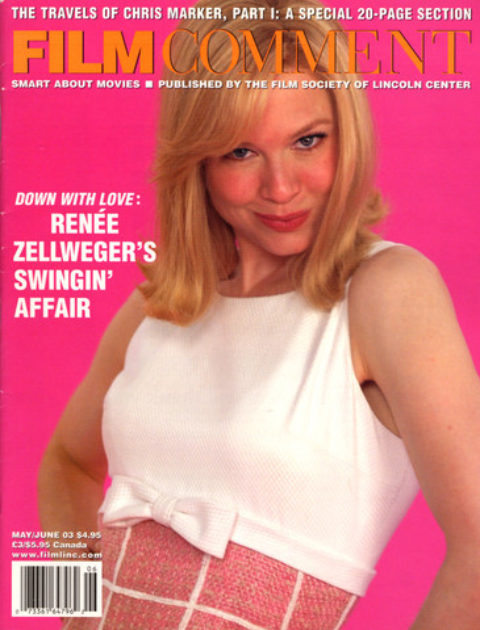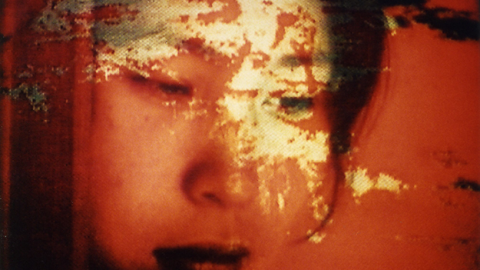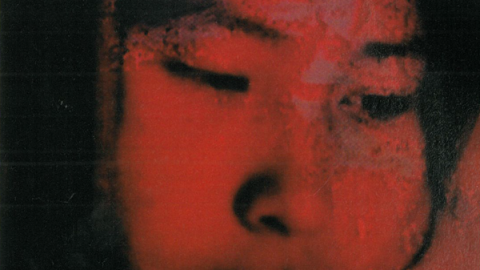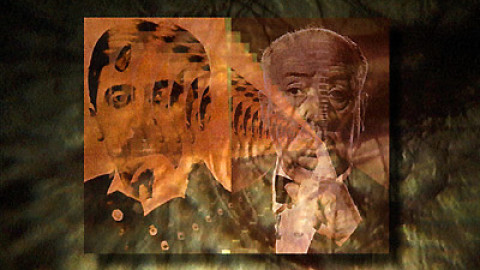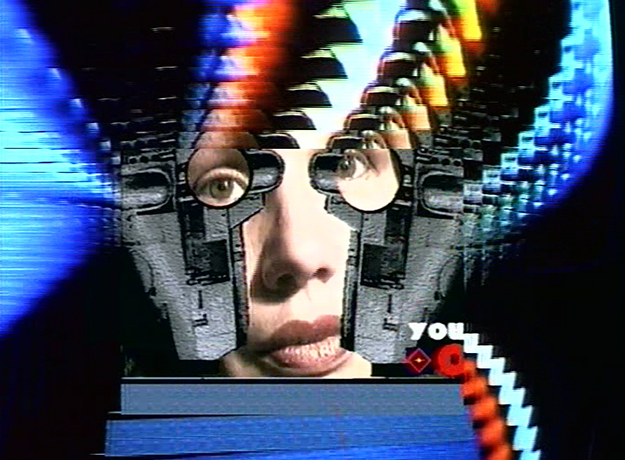
Level Five
I remember discussing Chris Marker’s last feature film, Level Five, with a friend of mine when it first came out. She was generally enthusiastic, but irritated by what she described as “an old man’s view of the Internet.” I did not share her annoyance, but I could see what she meant. Even at the moment of its release, before the impact of the accelerated obsolescence that today makes the film look definitively dated, the computer hardware and digital hypermedia effects—which both appear in Level Five as characters, and had been used to create it—looked distinctly quaint, old-fashioned, and clumsy. The Apple IIgs that is seen in the film was not a recent model, with its low-resolution screen and discolored plastic casing. I admired the “Gallery of the Masks” sequence for its lateral evocation of “Laura” (Catherine Belkhodja) as a mise-en-abyme of receding and ambiguous projections, and for Marker’s evident relish in amusing himself with Roger Wagner’s Hyperstudio; but nevertheless I winced inwardly at the awkwardness and tackiness of the effects, their uncomfortable echo of a late Seventies music video reinforced by a brashly pounding soundtrack.
Upon closer, renewed, or recollected acquaintance with Marker’s other recent multimedia works, I encountered further provocative tensions between my received sense of Marker as a new media pioneer and the jarring shocks of the old or willfully archaic. The 1990 installation Zapping Zone* invites random sampling and multilateral exploration of a series of discontinuous video and digital hypermedia sequences; yet physically it first strikes the eyes as a ramshackle, junkyard assemblage of elderly televisions and computer monitors. The fluid passage of cinematic fragments in Silent Movie (95), controlled by a digital interface that randomly determines the order in which themed film sequences and intertitles appear on five vertically stacked televisions, pulls against both the nostalgic lure of the old movie clips that have been sampled and reenacted, and the solid weight of the crude steel tower designed to hold the TVs, which Marker describes as his homage to Russian Constructivism in both form and roughness of materials. The user instructions for the cd-rom Immemory (98) anticipate and counter the temptation of high-speed processing by firmly advising the user “Don’t zap; take your time.” Immemory preserves the early technical limitations of the cd-rom with its small QuickTime video loops in the Cinema zone, and the processing glitches and lags that give the user no option but to navigate slowly and patiently.
Marker himself offers and explanation of such contraries: his notion of “naive informatics.” He compares his creative use of digital and computer tools to the work of 20th-century primitive painters like Henri Rousseau, describing himself as a “Sunday programmer,” a gentleman amateur of the digital era who rejects professional training and slick production values in favor of means that may be limited and deemed obsolete but that allow him to remain true to his own vision. Marker affirms his desire to work in an artisanal fashion with tools he can master himself, rather than opting for more sophisticated equipment and effects that would require the cooperation and collaboration of professional technicians, producers, and financiers.
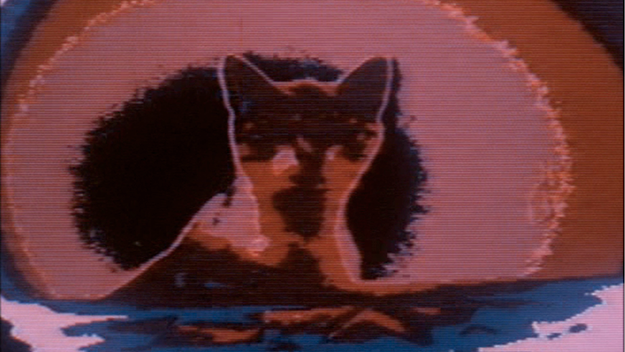
Sans soleil
Illuminating as these explanations are, they do not account for what interests me most about the dialectic of new and outmoded media in Marker’s recent projects: the impact of the “shock of the old” upon myself as a viewer or user of Marker’s works, which manifests itself as awkwardness and embarrassment, a dislocation of my sense of how such ostensibly cutting-edge works ought to appear. I imagine my reaction to be something like that of Walter Benjamin, faced with the spectacle of the fading, outmoded arcades of early 20th century Paris. Marker’s casting of the novel and the archaic together in his new media works functions as a critical gesture recalling the ur-history of contemporary technology—its obsolete, forgotten, and discarded fossils—and breaking the spell of a homogeneous, future-oriented technological present, whose history has been either evacuated or selectively manufactured. Benjamin’s sense of history forcibly obliterated and rewritten to suit the ideological interests of the present is engaged explicitly by Marker in his 1982 film Sans soleil. History, the commentary tells us, “throws its empty bottles out of the window, blocking memory as you might block your ears.” Sans soleil offers itself as an extended, digressive meditation on the role of film representations in creating history and memory; indeed in becoming history and memory, as the following passage from the commentary puts it:
“I remember that month of January in Tokyo—or rather I remember the images I filmed in that month of January in Tokyo. They have substituted themselves for my memory—they are my memory. I wonder how people remember things who don’t film, don’t photograph, don’t tape. How has mankind managed to remember? I know—the Bible. The new Bible will be the eternal magnetic tape of a time that will have to reread itself constantly just to know it existed.”
These oft-quoted lines seem to offer a poetic corroboration of the familiar founding principle of the study of memory: namely that memory is always a retrospective representation of past events, never the direct manifestation of the past in the present. The work of memory is to selectively reshape the past, and its existence depends upon the particular medium in which memories are articulated—whether spoken testimonies, written recollections, photographs, films, or multimedia installations. In Sans soleil memories are manifested as film images, with the distinction between subjective memory and visible image erased. The soundtrack of the film consists in part of spoken recollections, but these reach us by at least two removes—they are attributed to a fictional cameraman named Sandor Krasna, and represented in the form of letters read and commented upon by an unseen female narrator. This displacement of memory’s source alerts us to the fact that even the most apparently spontaneous verbal recollections are selected and given shape by established forms of representation.

Sans soleil
Sans soleil significantly anticipates the central preoccupations of Marker’s later film and multimedia projects by suggesting convergences between newer media technologies and memory. It celebrates the exaggerated visual mutations wrought upon mimetic film footage by the digital image synthesizer known as “the Zone,” precisely because they give concrete and graceful visual form to the distorting, transforming operations of remembrance. The Zone blocks the illusion that mimetic images of the past give us, which is that we can have immediate access to that past. Its synthetic image manipulations function both materially and metaphorically to underline the irretrievability of the past, the nature of memory as selective, transformative, and even aesthetic representation, and the fact that, by virtue of the novel technology adopted, memories are always formed in and for the present.
Primed by such insights, Level Five engages cyberspace as the medium for a concerted historical inquiry into the Battle of Okinawa, the last conventional battle of WWII. It enfolds a documentary investigation of the battle and its tragic consequences—the destruction of one third of the island’s civilian population and the mass suicides that followed the defeat of the Japanese army—within a fictional unfinished computer game whose creator has died in mysterious circumstances, leaving his lover, Laura, with the task of completing it. Laura’s historical research into the battle is entirely reliant on the infinite resources of the Optional World Link (OWL), an alter ego of the World Wide Web that is able to source information from every existing and possible database on the planet, whether past, present, or future. The game itself is programmed with the moral conscience that refuses to allow Laura to play the Angel of History and alter the outcome of the battle to produce a more palatable result; instead it forces her to confront the dreadful testimonies to the fill horror of the battle and its deadly aftermath.
Marker’s insistent use of new technologies as conduits of human memory and historical representation offers a challenge to the argument presented by Andreas Huyssen in his 1995 book Twilight Memories: Making Time in a Culture of America that new media are intrinsically unsuited to the processes of private and collective remembrance. Huyssen accounts for our cultural obsession with memory by suggesting that memory and memorial activities function as a “reaction formation” against a temporal crisis brought about by the ever-accelerating pace of technological change, and by the insidious tendency of new media to make all the information that they process appear of equal value. For Huyssen, memory represents a desire for contemplation and temporal grounding in a world dominated by “puzzling and often threatening heterogeneity, non-synchronicity and information overload.”
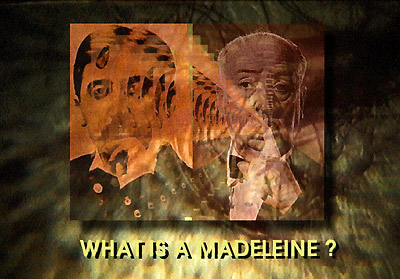
Immemory
In contrast to Huyssen’s pessimistic view, the digital media historian Lev Manovich proposes a striking affinity between new media and memory that closely echoes Marker’s preoccupations. In his essay “What Is Digital Camera?” Manovich writes: “The logic of replacement, characteristic of cinema, gives way to the logic of addition and coexistence. Time becomes spatialized, distributed over the surface of the screen. Nothing is forgotten, nothing is erased. Just as we use computers to accumulate endless texts, messages, notes, and data … ‘spatial montage’ accumulates events and images as it progresses through its narrative. In contrast to cinema’s screen, which primarily functioned as a record of perception, the computer screen functions as a record of memory.”
Level Five’s Laura anticipates Manovich when she imagines explaining to a future ethnographer how, at the close of the 20th century, people worshipped household familiar named computers, to whom they would confide all their memories. The logic of coexistence also underpins the cd-rom form assumed by Marker’s Immemory, through whose zones one may navigate in any direction and order, and where one can slip from one zone to another with the click of a mouse. In the introductory text to Immemory, Marker contends that the virtual architectures of cyberspace allow much closer approximations of the aleatory, non-linear drift of actual human recollection than do older media like film. The cd-rom format has allowed Marker to realize the long-cherished project of creating a topography of his own memory, much more effectively than Sans soleil and the earlier photo-film If I Had Four Camels (66), both of which may be regarded as prototype memory-maps in which Marker reflects, via the intermediary of alter egos, on a former period of his own history and creative work but which remain restricted by the linearity and fixed temporal rate of film.
Marker’s awareness and representation of memory is, however, more complex than I have suggested so far. While his works give intricate formal recognition to the truism that memory is always selective representation, Marker has also written “I claim, for the image, the humility and the powers of a madeleine.” The invocation of Proustian memory acknowledges an affective experience in which an arbitrary, unwilled, and trivial experience (famously, for Proust, the mouthful of madeleine soaked in herbal tea) triggers the complete return of the subject into a lived moment from their past. In proclaiming the image as a madeleine, Marker puts a different cast on the memory-images of Sans soleil. If the cameraman’s footage becomes his memory, perhaps it has precisely this power to return him involuntarily to that moment of his past, outside his habitual, meditated recollections. It is no longer the present that gives shape to the past, but the past that spontaneously and completely reasserts itself in the present.
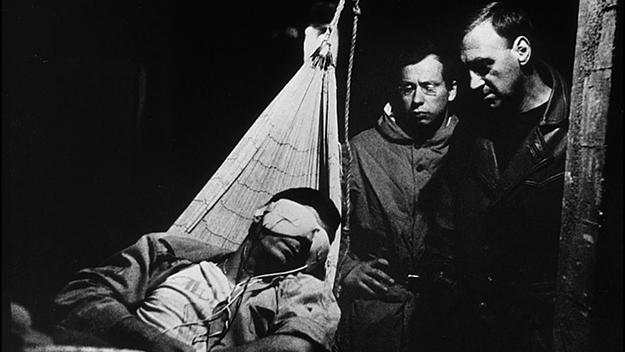
La Jetée
The access of memory provoked by the madeleine links to my unsettling experience of the archaic within the new technologies of Marker’s recent works. Both experiences disrupt the orderly temporality of existing in what Benjamin would have thought of as the “mythical” present, which is certain of its own identity in relation to past and future, and where progress from the past and into the future appears preordained and free of influence from historical forces of human choice and action.
The mythical present is especially dominant in the realm of discourse about new technologies, although this power is manifested, paradoxically, as an insistent orientation towards the future. The media historian William Boddy has examined some of the mythical dimensions in the development of popular discourses about virtual reality (VR). Quoting Tom Gunning’s observation that “technology can reveal the dream world of society as much as its pragmatic realization,” and extending it to include the ways in which we imagine and discuss new technological developments, Boddy reminds us that technological progress is never simply neutral, progressive, and practical, but is actively shaped by unconscious facets of desire and wish fulfillment as much as consciously formulated instrumental needs. He argues that we are inclined or invited to live so much in the fantasy world of what we think technology can, should, or might be that we ignore the gap between fantasy potential and pragmatic realization. Put another way, we often don’t acknowledge that the technology we have now does not match up to our mythic projections of its (rather than our own) capabilities. Boddy contrasts blithe, affirmative claims made by early advocates of VR that it would allow users to completely overcome the social and physical limitations of their bodies with more cautionary voices that remind us that the physical body cannot be transcended by VR, only temporarily repressed and forgotten.
Marker’s works offer an alternative means of navigating the gulf between the reality of technological developments and their fantasy potential. Their approach is to invoke the memory of the future in order to establish a historical, rather than a mythical, perspective on the present. The time travel narrative of La Jetée is perhaps the most obvious and the most complex example. The past of the film corresponds to the present in which it was made. Its fictional present is both an imagined future and a metaphorical displacement of traumatic and taboo aspects of postwar Europe’s historical past and the immediate present. The guards in the underground prison camp where the hero of the film is used for time travel experiments speak in German, and their actions also invoke the extensive use of torture by French authorities during the Algerian war. The future proper in La Jetée is a science-fiction projection of perfected human capability, which, significantly, is offered to the film’s hero but which he rejects if favor of annihilation in the past. Sans soleil describes a film that Sandor Krasna never made but that he was going to call Sans soleil. It concerns a time traveler from the year 4001 who returns to his planet’s past. He is drawn by a fragmented memory of the Mussorgsky song cycle that gave Krasna his film’s title, and by a compassionate fascination with the “third-worlders of time,” who are doomed to the pain of forgetting, but who, because of this, enjoy emotional experiences foreign to his own epoch. 2084, a ten-minute film made by Marker in 1984, imagines the French trade union centenary from another 100 years into the future and explicitly reminds viewers that the shape that history might take in the meantime is entirely up to them. Level Five projects its vision of the capacity of the Internet into a science-fiction future borrowed from William Gibson’s novel Neuromancer, in which computers users “jack in,” connecting their nervous systems directly to the network. Level Five’s imaginatively enhanced capacities for the World Wide Web make for a striking juxtaposition with the mundane-looking and old-fashioned technological hardware that appears in the film, underlining (rather than eliding) the gulf that exists between them.

Level Five
These science-fictional conceits are certainly playful, and may seem rather too obvious in their neat reversal of expectations to have much critical impact. Yet they do offer an insistent reminder of the present’s historical nature, by invoking a perspective from which our present has itself become absorbed by myth: either iconically frozen into manufactured nostalgia or simply cast into oblivion—another empty bottle tossed out the window. In borrowing the devices of science fiction, Marker’s projected futures may be read as engaged in their own fashion with Boddy’s analysis of the way that even our most pragmatic discussions of technological and scientific development are infused with a good measure of desire and fantasy projection.
Returning to my affective, awkward response to Level Five, I recognize that its power depends not only on my ability to understand Marker’s film as having the quality of Benjamin’s dialectical image, which can pull fragments of past and present (and indeed future) together in a constellation that activates historical consciousness. It also rests on the way that I am involuntarily returned to my own forgotten place within history. I am embarrassed because I am being returned to the moment when Level Five’s quaint-looking graphics were new and exciting, forced to recall a historical time I lived through but whose memory I have rewritten, forgotten, or repressed in order to subscribe to the myths of the technological present and future. My sense of shock comes from an Apple Mac that belongs to that ur-historical limbo of technology that is old enough to be obsolete but not safely old enough to have been recycled as nostalgia. Nothing looks so old-fashioned as that which has only just gone out of fashion. In trying to understand these responses to some of Marker’s works, I am compelled to understand myself as a participant in the myths of the present, and at the same time to grasp an alternative perspective on history that may have the potential to disrupt that mythologizing impulse.
* Zapping Zone is part of the permanent collection of the Musée National d’Art Moderne (Centre Georges Pompidou), Paris.



